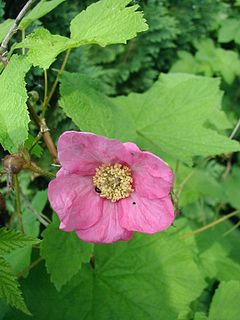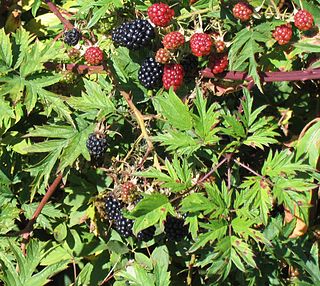
Rubus odoratus, the purple-flowered raspberry, flowering raspberry, or Virginia raspberry, is a species of Rubus, native to eastern North America, from Nova Scotia west to Ontario and Wisconsin, and south along the Appalachian Mountains as far as Georgia and Alabama.

Rubus pensilvanicus, known commonly as Pennsylvania blackberry, is a prickly bramble native to eastern and central North America from Newfoundland south to Georgia, west as far as Ontario, Minnesota, Nebraska, and Arkansas. The species is also established as a naturalized plant in California.

Rubus laciniatus, the cutleaf evergreen blackberry or evergreen blackberry, is a species of Rubus, native to Eurasia. It is an introduced species in Australia and North America. It has become a weed and invasive species in forested habitats in the United States and Canada, particularly in the Northeast and along the Pacific Coast.

Rubus ursinus is a North American species of blackberry or dewberry, known by the common names California blackberry, California dewberry, Douglas berry, Pacific blackberry, Pacific dewberry and trailing blackberry.

Rubus illecebrosus is a red-fruited species of Rubus that originally came from Japan, but is also very popular in some European countries like Lithuania. Common names include balloon berry and strawberry raspberry. It has become sparingly naturalized in scattered locations in Canada, the United States, and South America.
Rubus biformispinus, the pasture dewberry, is an uncommon North American species of flowering plant in the rose family. It is found in eastern and central Canada and the northeastern United States.

Rubus cuneifolius, the sand blackberry, is a North American species of flowering plant in the rose family. It occurs in the eastern United States in every coastal state from Louisiana to New Hampshire, with the exception of Rhode Island. There are also reports of inland populations in Tennessee, Arkansas, and Oklahoma, and the species has become naturalized in South Africa.
Rubus elegantulus, the showy blackberry, is an uncommon North American species of flowering plant in the rose family. It grows in the northeastern and north-central United States and eastern Canada.
Rubus flavinanus is a rare North American species of flowering plant in the rose family. It has been found only in the eastern United States primarily in the Appalachian Mountains of eastern West Virginia and western Maryland, but with a few populations in southern Vermont.
Rubus frondisentis is an uncommon North American species of flowering plant in the rose family. It has been found in Québec and in the northeastern United States.
Rubus setosus, the bristly blackberry, is a North American species of flowering plant in the rose family. It is widespread in much of central and eastern Canada and the northeastern and north-central United States
Rubus multiformis is an uncommon North American species of flowering plant in the rose family. It is found in eastern Canada and the northeastern and north-central United States.
Rubus recurvicaulis is an uncommon North American species of flowering plant in the rose family. It grows in eastern and central Canada and the north-central and northeastern United States.
Rubus permixtus is an uncommon North American species of flowering plant in the rose family. It grows in scattered locations in the north-central and northeastern United States, from Maine south as far as West Virginia plus Michigan and Wisconsin. Nowhere is it very common.
Rubus glandicaulis is a North American species of flowering plant in the rose family. It is native to eastern and central Canada and the northeastern and north-central United States.
Rubus vermontanus is a rare North American species of flowering plants in the rose family. It is found in eastern and central Canada and the northeastern and north-central United States.
Rubus plicatifolius is a North American species of dewberry in the rose family. It is found in eastern and central Canada and in the eastern and central United States.
Rubus recurvans is an uncommon North American species of brambles in the rose family. It is found in eastern and central Canada and in the eastern and north-central United States.
Rubus regionalis is an uncommon North American species of flowering plant in the rose family. It grows in eastern and central Canada and the north-central and northeastern United States.
Rubus semisetosus is uncommon North American species of brambles in the rose family. It grows in the Canadian Province of Nova Scotia as well as in the northeastern and north-central United States from New England to Minnesota.





